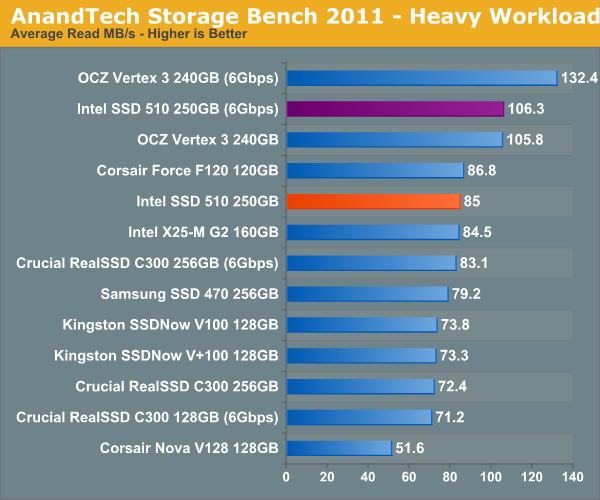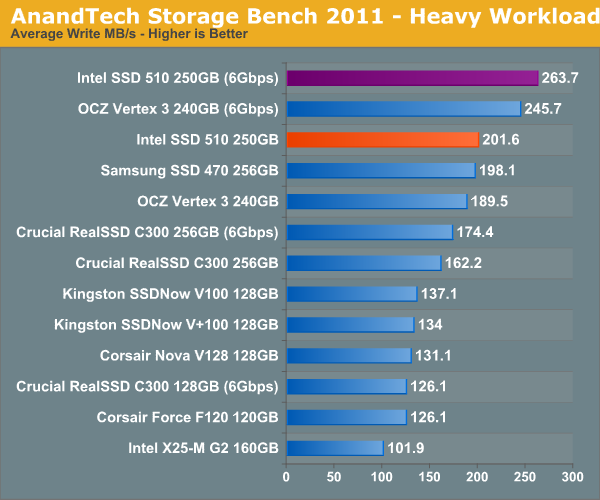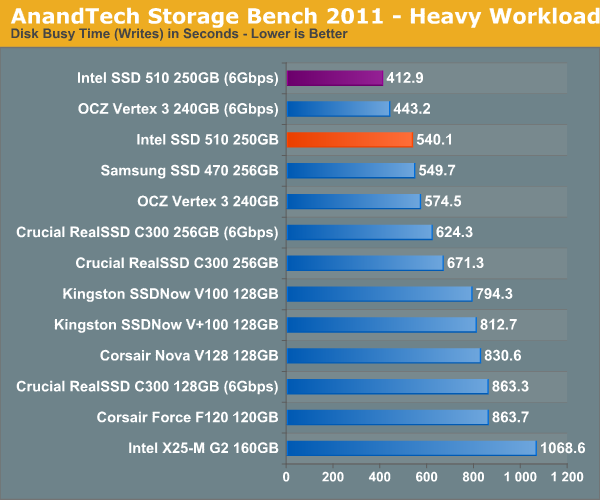The Intel SSD 510 Review
by Anand Lal Shimpi on March 2, 2011 1:23 AM EST- Posted in
- IT Computing
- Storage
- SSDs
- Intel
- Intel SSD 510
AnandTech Storage Bench 2011: Much Heavier
I didn't expect to have to debut this so soon, but I've been working on updated benchmarks for 2011. Last year we introduced our AnandTech Storage Bench, a suite of benchmarks that took traces of real OS/application usage and played them back in a repeatable manner. I assembled the traces myself out of frustration with the majority of what we have today in terms of SSD benchmarks.
Although the AnandTech Storage Bench tests did a good job of characterizing SSD performance, they weren't stressful enough. All of the tests performed less than 10GB of reads/writes and typically involved only 4GB of writes specifically. That's not even enough exceed the spare area on most SSDs. Most canned SSD benchmarks don't even come close to writing a single gigabyte of data, but that doesn't mean that simply writing 4GB is acceptable.
Originally I kept the benchmarks short enough that they wouldn't be a burden to run (~30 minutes) but long enough that they were representative of what a power user might do with their system.
Not too long ago I tweeted that I had created what I referred to as the Mother of All SSD Benchmarks (MOASB). Rather than only writing 4GB of data to the drive, this benchmark writes 106.32GB. It's the load you'd put on a drive after nearly two weeks of constant usage. And it takes a *long* time to run.
I'll be sharing the full details of the benchmark in some upcoming SSD articles but here are some details:
1) The MOASB, officially called AnandTech Storage Bench 2011 - Heavy Workload, mainly focuses on the times when your I/O activity is the highest. There is a lot of downloading and application installing that happens during the course of this test. My thinking was that it's during application installs, file copies, downloading and multitasking with all of this that you can really notice performance differences between drives.
2) I tried to cover as many bases as possible with the software I incorporated into this test. There's a lot of photo editing in Photoshop, HTML editing in Dreamweaver, web browsing, game playing/level loading (Starcraft II & WoW are both a part of the test) as well as general use stuff (application installing, virus scanning). I included a large amount of email downloading, document creation and editing as well. To top it all off I even use Visual Studio 2008 to build Chromium during the test.
Many of you have asked for a better way to really characterize performance. Simply looking at IOPS doesn't really say much. As a result I'm going to be presenting Storage Bench 2011 data in a slightly different way. We'll have performance represented as Average MB/s, with higher numbers being better. At the same time I'll be reporting how long the SSD was busy while running this test. These disk busy graphs will show you exactly how much time was shaved off by using a faster drive vs. a slower one during the course of this test. Finally, I will also break out performance into reads, writes and combined. The reason I do this is to help balance out the fact that this test is unusually write intensive, which can often hide the benefits of a drive with good read performance.
There's also a new light workload for 2011. This is a far more reasonable, typical every day use case benchmark. Lots of web browsing, photo editing (but with a greater focus on photo consumption), video playback as well as some application installs and gaming. This test isn't nearly as write intensive as the MOASB but it's still multiple times more write intensive than what we were running last year.
As always I don't believe that these two benchmarks alone are enough to characterize the performance of a drive, but hopefully along with the rest of our tests they will help provide a better idea.
The testbed for Storage Bench 2011 has changed as well. We're now using a Sandy Bridge platform with full 6Gbps support for these tests. All of the older tests are still run on our X58 platform.
AnandTech Storage Bench 2011 - Heavy Workload
We'll start out by looking at average data rate throughout our new heavy workload test:

There's simply no dethroning the Vertex 3, but Intel's SSD 510 does come dangerously close. Over a 6Gbps interface the 510 delivers 93% of the performance of the Vertex 3. Over a 3Gbps interface the gap narrows to a meager 5.2%.
The breakdown of reads vs. writes tells us more of what's going on:

The Vertex 3 is nearly 25% faster than the 510 if we just isolate the reads conducted by our benchmark. Remember the poor random read performance? I suspect that's at play here. The Intel SSD 510 on a 6Gbps interface is about the speed of the Vertex 3 on a 3Gbps port.

Ah ha! This is where the picture shifts. Our heavy workload does have a significant amount of incompressible writes which significantly reduce the performance of the Vertex 3. The V3 loses enough ground that the 510 is 7% faster in writes during our benchmark.
The next three charts just represent the same data, but in a different manner. Instead of looking at average data rate, we're looking at how long the disk was busy for during this entire test. Note that disk busy time excludes any and all idles, this is just how long the SSD was busy doing something:













128 Comments
View All Comments
deadsmeat - Wednesday, March 2, 2011 - link
I am not sure if I missed it, but will you do a price/performance for SSDs? For example, and Intel or Corsair SSD migth be the fastest, but if it has a good price/performance vs the fastest SSD then it's something that consumers might consider when getting an SSD.I don't have a clear "performance" since you have run many benchmark in there, but something like a "real world load" would be good to see. I may not want the fastest SSD, but I will be looking for something that has good over-all balance in performance, and not so heavy on the pocket...
deadsmeat - Wednesday, March 2, 2011 - link
Woops, I missed "not" i.e.Intel or Corsair SSD might NOT be the fastest, but if it has a good price/performance vs the fastest SSD then it's something that consumers might consider when getting an SSD.
dagamer34 - Wednesday, March 2, 2011 - link
I thought that's what the light benchmark was, more "normal" tasks that aren't super-abusive with the SSD.vol7ron - Wednesday, March 2, 2011 - link
Yes, light being "AnandTech Storage Bench 2011 - Light Workload".Either Light or Heavy depending on your use seems to be a combination of both random and sequential performance.
As stated in the article:
"I'll be sharing the full details of the benchmark in some upcoming SSD articles but here are some details:
1) The MOASB, officially called AnandTech Storage Bench 2011 - Heavy Workload, mainly focuses on the times when your I/O activity is the highest. There is a lot of downloading and application installing that happens during the course of this test. My thinking was that it's during application installs, file copies, downloading and multitasking with all of this that you can really notice performance differences between drives.
2) I tried to cover as many bases as possible with the software I incorporated into this test. There's a lot of photo editing in Photoshop, HTML editing in Dreamweaver, web browsing, game playing/level loading (Starcraft II & WoW are both a part of the test) as well as general use stuff (application installing, virus scanning). I included a large amount of email downloading, document creation and editing as well. To top it all off I even use Visual Studio 2008 to build Chromium during the test."
therealnickdanger - Wednesday, March 2, 2011 - link
What price would you use? MSRP? Newegg after MIR? Just pick a usage scenario that fits your usage and divide the score by the dollar amount of your favorite e-tailer... Pretty simple.vol7ron - Wednesday, March 2, 2011 - link
Why not have both? AT has used a price grabber in the past.Actually, where did that go? It started to break down on the old site, but I'd like to see AT put that part shopper back up.
MrDiSante - Wednesday, March 2, 2011 - link
Realistically speaking, if you're buying computer components/peripherals, the functionRetailer GetLowestPrice(Component component)
{
return Newegg;
}
would probably be better than the average price comparison site.
marraco - Wednesday, March 2, 2011 - link
To be useful, the comparison needs to consider RAID 0 setups.dagamer34 - Wednesday, March 2, 2011 - link
It seems like the one true major difference between the Intel SSD 510 and the OCZ Vertex 3 is that one is available now while the other is only talked about in reviews. First to market is always a benefit for a manufacturer that has a decently performing product, though Newegg's markup makes early adopter's pay dearly for it.Of course, this leads to the important question of "when will the Vertex 3 series reach general availability?" I recently purchased a 120GB OCZ Vertex 2 for a new 2011 17" MacBook Pro and the performance is stunning compared to the stock HDD (it's my first SSD). I'm wondering if I should return the drive and just wait for the Vertex 3 because once you've gone SSD, it is so hard to go back!
Thanks for the review Anand!
dagamer34 - Wednesday, March 2, 2011 - link
Oh, another thing. Are we going to get an SSD State of the Union for 2011? I'm guessing you're waiting to finish the reviews of most of the SSDs that are coming out this year first... Yeah, I just answered my own question, I think. :)